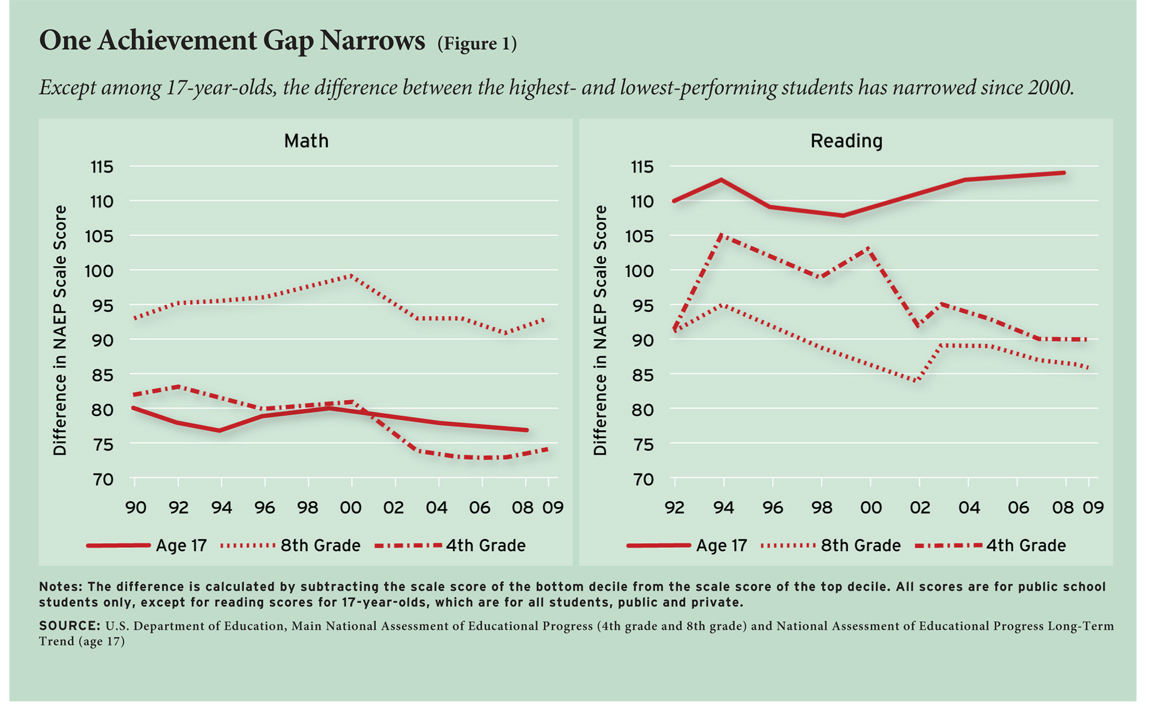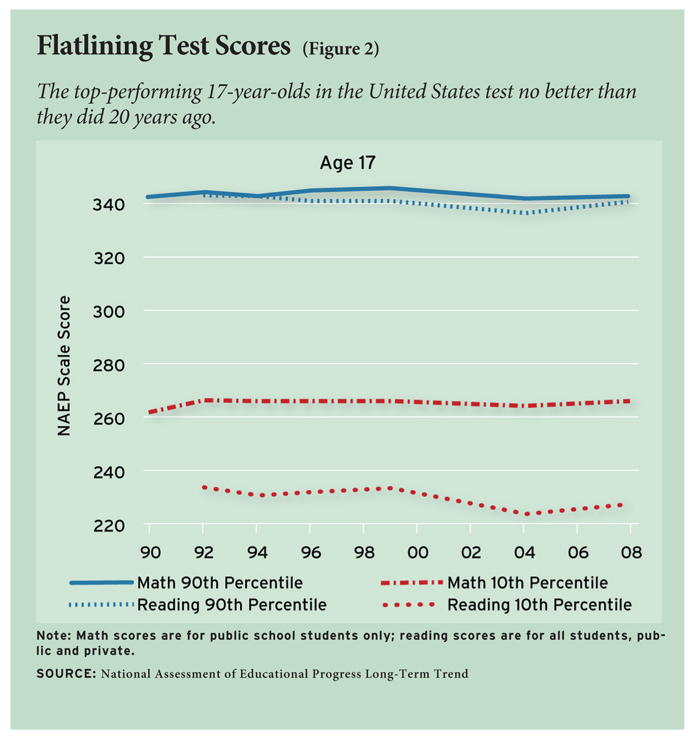Education Next talks with Richard A. Epstein, Daniel Pianko, Jon Schnur, and Joshua Wyner
For a decade, at least since the passage of No Child Left Behind, the nation’s foremost education goal has been to erase achievement “gaps” in which African American, Latino, and low-income students dramatically lag behind their peers. This emphasis has enjoyed broad support through the Bush and Obama administrations, and from major funders, but it raises the question of whether high achievers and gifted students have been overlooked along the way. Has a focus on reading and math proficiency, and on boosting graduation rates, meant less attention and support for the “talented tenth”? Richard A. Epstein, professor of law at New York University School of Law and senior lecturer at the University of Chicago, and Daniel Pianko, a partner at University Ventures Fund, argue that high achievers have paid a high price for our attention to struggling students. Jon Schnur, chairman of the board of New Leaders for New Schools, and Joshua Wyner, of the Aspen Institute, see no tension, and argue that equity-focused efforts to improve teaching and learning benefit students across the board.
Education Next: Is the education of the most able students in the United States being shortchanged? What evidence would you cite to support your position?

Jon Schnur and Joshua Wyner: Too many of our students at every achievement level are being shortchanged. Based solely on their race, ethnicity, and socioeconomic status, there are students at high, middle, and low levels of achievement who are not receiving the educational challenges they need to succeed and excel. While we have a growing and important number of small-scale breakthrough successes in American education, recently announced Program for International Student Assessment (PISA) results and other analyses show that we have performance gaps for our students at all levels of achievement relative to their peers internationally.
According to the 2009 PISA results, the U.S. ranked 14th in reading, 25th in math, and 17th in science among the 34 OECD (Organisation for Economic Co-operation and Development) countries. When we unpack these data, we see that U.S. students perform well below the standard of readiness for college and/or careers, regardless of where they fall on the achievement continuum.

Meanwhile, within the United States, modest advances in the number of students achieving proficiency have not been accompanied by similar increases in the number of students from all backgrounds achieving at advanced levels. In a 2008 study, Tom Loveless found that from 2000 to 2007 our nation’s highest-performing 10 percent of students made much smaller gains on the National Assessment of Educational Progress (NAEP) than our lowest-achieving 10 percent. A similar trend existed in some grades and subjects during the prior decade (see Figure 1). We need to make dramatically greater progress to help more students reach and remain at the highest level of achievement.

While race- and income-based gaps are narrowing to some extent (especially in the earlier grades), four common but faulty assumptions could block progress toward closing these and other serious achievement gaps:
First, while most American schools will have to improve for our nation to reach internationally competitive education levels, many Americans assume that performance gaps exist only in someone else’s community or schools. In a 2010 PDK/Gallup poll, only 18 percent of Americans surveyed graded our public schools nationally at an “A” or “B.” By contrast, 77 percent of public school parents gave their oldest child’s school an A or B, a percentage that grew by eight points over the prior five years. To offset such misperceptions, we need to require that all schools in all districts report student performance—and calculate achievement gaps—using the same, internationally benchmarked standards.
Second, some mistakenly assume that a “talented tenth” strategy should focus on the schools and communities that already tend to achieve at the highest levels. The 2008 Achievement Trap study (Jack Kent Cooke Foundation) shows that low-income
students are less likely than other students to reach or remain at advanced levels of education at every grade. Access to rigorous coursework is unevenly distributed across American high schools, as shown by national audits of AP classes conducted by the College Board. And recent reports show that the fastest-growing gap between black and white students is at advanced levels of achievement. This is not surprising in some ways, given problems in current educational practice: we tend to provide less funding, have fewer outstanding teachers and principals, and require less rigorous coursework in schools that serve lower-income students. Not only is this grossly unfair, but our nation’s economic competitiveness, given both the larger populations of countries like China and India and our rapidly increasing diversity, will depend on our tapping students from all backgrounds in order to supply the innovators, engineers, and leaders we need to succeed.
The promising news is that we know the potential to achieve at the most advanced levels is distributed widely. The growin
g number of schools successfully serving low-income students provides hard evidence that when these students have access to an excellent education they can reach levels achieved by their affluent peers. When schools and systems aim to improve what matters most, the entire culture and practice in a school building can change. Such schools hold expectations high and ensure teacher and school-leader excellence and effectiveness.
A poorly conceived “talented tenth” initiative risks failing to capitalize on the potential of students of all backgrounds to achieve at the highest levels. To avoid that outcome, we need to dramatically increase the number of high-performing schools serving low-income students.
Third, some assume that students already achieving at the highest levels will be successful without additional educational interventions and progress. But studies show that many students at the most advanced levels don’t stay at that level without intensive work. Moreover, the stagnation of performance among America’s most-advanced students shows the consequences of failing to meet their educational needs.
Finally, some falsely assume that the question is how we split up the existing pie of educational focus. Changing entire systems of education is the best strategy for improving overall performance and increasing the performance of advanced students, while also closing achievement gaps. A 2010 study by Richard Freeman and colleagues shows that countries that perform best on TIMSS (Trends in International Mathematics and Science Study) not only have a higher average score, but also have 1) less variation in performance and 2) smaller achievement gaps between different demographic groups. McKinsey & Co.’s most recent education report on how the best school systems improve cites evidence from Singapore, Finland, and elsewhere that improving overall performance can best be accomplished at the same time achievement gaps are closed.
 Richard Epstein and Daniel Pianko: Enormous sums of money have been poured into grades K through 12 since 1970. Measured in constant 2007 dollars, the expenditure per pupil in the United States more than doubled, from $4,060 in 1970 to $9,266 in 2008. Over that same period, achievement levels for students at age nine showed a moderate increase. Achievement levels for those aged 17 have been dead-level since 1990 (see Figure 2). A stagnant educational record in the face of massive increases in expenditures means that the current system has the unique distinction of failing both its strongest and its weakest students.
Richard Epstein and Daniel Pianko: Enormous sums of money have been poured into grades K through 12 since 1970. Measured in constant 2007 dollars, the expenditure per pupil in the United States more than doubled, from $4,060 in 1970 to $9,266 in 2008. Over that same period, achievement levels for students at age nine showed a moderate increase. Achievement levels for those aged 17 have been dead-level since 1990 (see Figure 2). A stagnant educational record in the face of massive increases in expenditures means that the current system has the unique distinction of failing both its strongest and its weakest students.
As Hanushek, Peterson, and Woessmann have shown, our best and brightest have been treading water, while other countries have caught up with or passed the United States. The most recent PISA results place the United States 31st of 56 participating countries in the percentage of students achieving at an advanced level in mathematics (see “Teaching Math to the Talented,” features, Winter 2011). These weak numbers complicate the challenge posed by Schnur and Wyner. Unfortunately, not every student can benefit from advanced education, and it could well be that the best way to increase performance is to reduce the number of students included in these programs while continuing to focus on bringing all students to international standards. It is most difficult to broaden a base and increase average quality at the same time.

Indeed, within the current milieu, one major drawback is that our most able students are not so much “shortchanged” as they are ignored. One telling sign is that the federal government does not impose minimum standards for gifted education, even though the No Child Left Behind law imposes all sorts of mandates to bring up the bottom. Nor does the federal government allocate dollars to gifted education. The one program of note, the Jacob Javits Gifted and Talented Students Education Act, has a long title, but its total expenditures were $7.5 million for 2008 out of the roughly $40 billion of allocated federal funds, a drop in the proverbial bucket in a nation where 6 percent of all students, some 3 million, are classified as gifted.
The situation at the state level is so erratic as to be schizophrenic. Illinois, for example, has one statewide test to identify the top math and science students and bring them together in one school. But most states do not allocate any funds specifically for gifted and talented students. New York City runs an extensive system for gifted and talented students, but the special appropriations at the state level are exactly $0. States are hard-strapped for cash, so there is little reason to think that these policies will be reversed with time.

State political leaders realize it is easier to ignore the needs of high-performing students. Tracking students into high-performing schools touches a third rail of racial politics. Unfortunately, it is likely that Caucasian and Asian students would disproportionately obtain places in these elite schools, which in the eyes of some would only widen the achievement gap. While the revolt against tracking students has had limited impact on those needing additional help, our nation has lost out on the long-term gains that gifted students could supply.
EN: In the past two decades, education policy has emphasized closing the achievement gap between low performers and high performers by raising the achievement of the low performers. Have the most-talented students paid a price for this focus?
Epstein & Pianko: Addressing the plight of students who are left behind is a noble, important goal. But the two goals of educating all Americans and providing the talented tenth with the specialized instruction they need do not have to be mutually exclusive. The Holy Grail of educators for the past 20-plus years has been to find ways for students of different abilities and aptitudes to learn at different paces in the same classroom. Educators have developed remarkably effective methods for achieving this goal for the early grades. However, this paradigm starts to break down by the time students reach middle school. The challenges become insuperable by the time students reach high school. The difference between those students capable of doing calculus and those who are barely ready for geometry, is too dramatic for even the ablest teachers to span in one classroom. Either there is separate education, with whatever perceived stigma it might have, or students at both ends of the spectrum will languish.
The real issue is a perception that a focus on gifted programs must automatically detract from children who are not achieving at grade level. To the contrary, the Loveless study cited above offers some support for the proposition that high performers suffer systematically from the focus on closing the achievement gap, while there is limited data that grouping all students together improves the quality of education for struggling students. No Child Left Behind only aggravates the problem because it is directed solely at keeping students and the schools that they attend above some failure line. A 10 percent improvement in the performance of gifted students counts for naught if a tiny fall in the performance of the weakest students puts the school out of compliance with federal standards. As elsewhere in life, you get what you measure and pay for. Policymakers expend virtually all dollars to cluster students above some pass-fail line, not for excellence at the top.
Schnur & Wyner: The answer to both parts of this question is no.
Policies over the past decade have neither substantially harmed nor significantly helped the achievement of our highest-performing students. While we haven’t seen substantial gains for students at advanced levels, there is no evidence to suggest that there have been overall declines, either. Still, we can’t afford stagnation of performance for any of our students.
EN: What policies would you support to ensure America’s future competitiveness and prosperity? Should we target our limited resources to boost literacy and numeracy in the general population or invest in STEM (Science, Technology, Engineering, and Mathematics) and other programs aimed at the “talented tenth”?
Schnur & Wyner: As we argue above, the evidence shows this is a false choice. The data from countries around the world refute the fundamental assumption that we can only do one or the other. The highest-performing countries in the world not only have the highest raw achievement scores, but also the smallest achievement gaps between subgroups within their population. High-functioning education systems that pay attention to the needs of individual students serve all children well. Therefore, it is not a decision about how to target scarce resources to one specific subgroup at the expense of another.
Ultimately, America’s competitive advantage rests on a public education system that pushes beyond the limits of the “talented tenth” paradigm and fully develops the human capital of far more of our students. After all, if we can only rely on our top 10 percent to drive our economy, we’re on a losing path, since China and India are already fielding competitive teams of far greater size.
That’s why we need an education agenda that strategically recruits, retains, and rewards the most effective teachers and principals; that builds incredibly high standards; that develops rigorous and useful assessments to measure progress against those standards; that builds data systems that allow teachers, principals, students, and parents to quickly and conveniently access those data for everyday use; and that focuses on dramatic intervention within our country’s lowest-performing schools. We need an accountability system that holds schools and school systems accountable for all of their students, including the lowest- and highest-achieving.
This comprehensive approach offers the best chance to improve outcomes for every student, from our “talented tenth” to students languishing grade levels behind. It guarantees that we have a system that attracts the best talent to support success, sets clear goals, measures progress toward those goals, gives educators information they can use to improve student outcomes, and demands dramatic action in the face of persistent failure. A few specific policies can help foster this reality:
Raise K–12 standards to assess and drive readiness for success in college and careers. Improve the rigor of what students are taught and build better tools for assessing what they have learned. Tremendous recent progress has been made through adoption of the Common Core by 44 states and the nascent plans of multistate consortia to create better tests of student work that align with the Common Core.
Increase access to the most rigorous courses. Ensure that every high school offers high-quality AP classes in core subjects and that districts prepare students of every racial and socioeconomic group in earlier grades to succeed in AP.
Set targets for advanced learning and measure student growth toward them. Continue the state-by-state efforts to measure the growth of every student. Assiduously collect and report the numbers of advanced learners as well as gaps between subgroups, and hold educators accountable for ensuring that gaps are closed at every level of achievement, including advanced. At the same time, we can’t allow for definitions of academic growth and achievement to focus too narrowly on exams (the approach embodied by NCLB). Instead, we know that students learn, think, operationalize, and develop differently—they all have the potential to serve as our next generation of innovators, entrepreneurs, and scientists.
Adopting these policies can contribute to a culture in which we have high aspirations for every student, hold great expectations for every teacher, and no longer abide the notion that our nation must choose between excellence and equity. In the end, only if we reform our schools at scale to improve teaching practice will we succeed. By driving every education practice toward excellent outcomes for every child, intentionally moving each student from where they are to a much higher level, our nation will be able to realize its ideal of eliminating gaps in education and opportunity and, thereby, regain its place among the world’s education leaders.
Epstein & Pianko: It is a national economic imperative that the United States maintain its (fast-eroding) advantage in innovation, which comes from the talented tenth. There is a tremendous body of research that shows that innovation, which sparks new industries and job creation, originates from the minds of a few. Since we fail to focus attention on increasing the aggregate number of Americans capable of achieving radical innovation or starting new entrepreneurial endeavors, we have likely sacrificed any number of start-ups that could have led to a Fortune 500 company or the next Facebook.
Figuring out how to do this is of course the hardest problem. Schnur and Wyner point to the role of increased standards through the Common Core and the success of certain high-performing schools. The Common Core, even assuming the most robust application, sets a baseline that by definition our future Facebook founders must exceed by orders of magnitude. We agree wholeheartedly that the standards for all students must be raised dramatically, but the opportunities for our highest-achieving students must include coursework that is radically beyond the Common Core.
Fundamentally, we do not accept that this is an “either/or” debate about whether to prioritize low- or high-performing students. We believe that there is a “both/and” solution that drives achievement for all students. All students would benefit from allowing self-directed, advanced learners to take some portion of their coursework online and/or at their own pace. Technology has opened up a remarkably cheap and efficient methodology for providing individually tailored instruction. State and federal policymakers must move decisively to create online programs to expand learning options for all students, including the talented tenth (see “Virtual Schoolteacher,” school life). States and/or the federal government could identify best practices for online skill assessments that all students could take at key break points in their school careers (e.g., 6th grade or 9th grade). Students who score well on such an exam could 1) complete lower-level coursework by learning online at their own pace so they can advance more quickly to higher-level coursework and 2) take advantage of a national network of advanced coursework.
Ideally, students would proceed online at their own pace and have access to in-person teacher assistance as needed. New York City, through its School of One and iZone/iLearn programs, is piloting such a strategy right now. Policymakers should encourage (or push) districts to create similar options for their students by tying Title I and other federal aid programs to initiatives that promote online learning for the most talented students and that also provide physical locations for these students to do their advanced group work. For example, each intermediate unit or district of more than 50,000 students might be required to create math and science academies, which offer a portion of their instruction online, with in-person practical application or advanced work. Allowing students to continue in regular schools for some courses while doing advanced work in others (see “High Schoolers in College,” features) may well be the best solution.
This article appeared in the Summer 2011 issue of Education Next. Suggested citation format:
Epstein, R.A., Pianko, D., Schnur, J., and Wyner, J. (2011). Are We Lifting All Boats or Only Some? Equity versus excellence and the talented tenth. Education Next, 11(3), 46-53.



